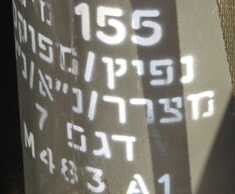Human Rights Watch 24 July 2006

Pallets of 155mm artillery projectiles including DPICM cluster munitions (center and right with yellow diamonds) in the arsenal of an IDF artillery unit on July 23 in northern Israel. Each DPICM shell contains 88 sub-munitions, which have a dud rate of up to 14 percent. (Human Rights Watch)
Israel has used artillery-fired cluster munitions in populated areas of Lebanon, Human Rights Watch said today. Researchers on the ground in Lebanon confirmed that a cluster munitions attack on the village of Blida on July 19 killed one and wounded at least 12 civilians, including seven children. Human Rights Watch researchers also photographed cluster munitions in the arsenal of Israeli artillery teams on the Israel-Lebanon border.
“Cluster munitions are unacceptably inaccurate and unreliable weapons when used around civilians,” said Kenneth Roth, executive director of Human Rights Watch. “They should never be used in populated areas.”
According to eyewitnesses and survivors of the attack interviewed by Human Rights Watch, Israel fired several artillery-fired cluster munitions at Blida around 3 p.m. on July 19. The witnesses described how the artillery shells dropped hundreds of cluster submunitions on the village. They clearly described the submunitions as smaller projectiles that emerged from their larger shells.

Close-up of a M483A1 DPICM artillery-delivered cluster munition present in the arsenal of an IDF unit in northern Israel. (Human Rights Watch)
Human Rights Watch researchers photographed artillery-delivered cluster munitions among the arsenal of Israel Defense Forces (IDF) artillery teams stationed on the Israeli-Lebanese border during a research visit on July 23. The photographs show M483A1 Dual Purpose Improved Conventional Munitions, which are U.S.-produced and -supplied, artillery-delivered cluster munitions. The photographs contain the distinctive marks of such cluster munitions, including a diamond-shaped stamp, and a shape that is longer than ordinary artillery, according to a retired IDF commander who asked not to be identified.
The M483A1 artillery shells deliver 88 cluster submunitions per shell, and have an unacceptably high failure rate (dud rate) of 14 percent, leaving behind a serious unexploded ordnance problem that will further endanger civilians. The commander said that the IDF’s operations manual warns soldiers that the use of such cluster munitions creates dangerous minefields due to the high dud rate.
Lebanese security forces, who to date have not engaged in the fighting between Israel and Hezbollah, also accused Israel of using cluster munitions in its attacks on Blida and other Lebanese border villages. These sources also indicated they have evidence that Israel used cluster munitions earlier this year during fighting with Hezbollah around the contested Shebaa Farms area. Human Rights Watch is continuing to investigate these additional allegations.
Human Rights Watch believes that the use of cluster munitions in populated areas may violate the prohibition on indiscriminate attacks contained in international humanitarian law. The wide dispersal pattern of their submunitions makes it very difficult to avoid civilian casualties if civilians are in the area. Moreover, because of their high failure rate, cluster munitions leave large numbers of hazardous, explosive duds that injure and kill civilians even after the attack is over. Human Rights Watch believes that cluster munitions should never be used, even away from civilians, unless their dud rate is less than 1 percent.
Human Rights Watch conducted detailed analyses of the U.S. military’s use of cluster bombs in the 1999 Yugoslavia war, the 2001-2002 Afghanistan war, and the 2003 Iraq war. Human Rights Watch research established that the use of cluster munitions in populated areas in Iraq caused more civilian casualties than any other factor in the U.S.-led coalition’s conduct of major military operations in March and April 2003, killing and wounding more than 1,000 Iraqi civilians. Roughly a quarter of the 500 civilian deaths caused by NATO bombing in the 1999 Yugoslavia war were also due to cluster munitions.
“Our research in Iraq and Kosovo shows that cluster munitions cannot be used in populated areas without huge loss of civilian life,” Roth said. “Israel must stop using cluster bombs in Lebanon at once.”
Human Rights Watch called upon the Israel Defense Forces to immediately cease the use of indiscriminate weapons like cluster munitions in Lebanon.
Background
Israel used cluster munitions in Lebanon in 1978 and in the 1980s. At that time, the United States placed restrictions on their use and then a moratorium on the transfer of cluster munitions to Israel out of concern for civilian casualties. Those weapons used more than two decades ago continue to affect Lebanon.
Israel has in its arsenal cluster munitions delivered by aircraft, artillery and rockets. Israel is a major producer and exporter of cluster munitions, primarily artillery projectiles and rockets containing M85 DPICM (Dual Purpose Improved Conventional Munition) submunitions. Israeli Military Industries, an Israeli government-owned weapons manufacturer, has reportedly produced more than 60 million M85 DPICM submunitions. Israel also produces at least six different types of air-dropped cluster bombs, and has imported from the United States M26 rockets for its Multiple Launch Rocket Systems.
There is growing international momentum to stop the use of cluster munitions. Belgium became the first country to ban cluster munitions in February 2006, and Norway announced a moratorium on the weapon in June 2006. Cluster munitions are increasingly the focus of discussion at the meetings of the Convention on Conventional Weapons, with ever more states calling for a new international instrument dealing with cluster munitions.
Human Rights Watch is a founding member, and a steering committee member, of the Cluster Munition Coalition.
Related Links